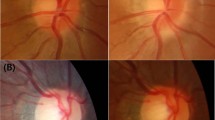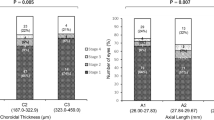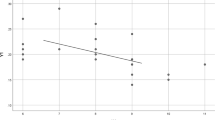Abstract
Purpose
To analyze the change in refractive error and the axial length of chronic Vogt–Koyanagi–Harada (VKH) disease.
Methods
Medical records of 106 eyes of 54 adult VKH patients were analyzed. The refractive error and the axial length were compared between the baseline (defined as the time point at least 2 weeks after acute stage of VKH) and the final visit. The rate of the eyes with significant myopia progression [defined as refraction change toward myopia > 1 diopter (D)] was examined. The correlation of the degree of sunset glow fundus/choroidal thickness with the change in refractive error was also evaluated.
Results
At the final visit, the mean refractive error was more myopic and the axial length was longer than at baseline. Seventeen of the 106 eyes (16.0%) showed significant myopia progression. The mean change in refractive error during a follow-up in these 17 eyes was − 2.7 D (range − 7.5 to − 1.1 D). The axial length data both at baseline and at the final visit were obtained only in 8 eyes. The mean change in axial length during a follow-up in these 8 eyes was 1.3 mm (range 0–3.7 mm). In the cases with myopia progression, sunset glow fundus was more frequent and subfoveal choroid was thinner than those without myopia progression.
Conclusions
Myopia progression as well as increase in axial length occurs in VKH disease. The link between choroidal thinning and axial length elongation in VKH patients gives some insights into axial length increase of pathologic myopia.






Similar content being viewed by others
References
Rao NA, Moorthy RS, Inomata H (1995) Vogt–Koyanagi–Harada syndrome. Int Ophthalmol Clin 35(2):69–86
Rao NA, Gupta A, Dustin L, Chee SP, Okada AA, Khairallah M et al (2010) Frequency of distinguishing clinical features in Vogt–Koyanagi–Harada disease. Ophthalmology 117(3):591 e591–599 e591
Inomata H, Rao NA (2001) Depigmented atrophic lesions in sunset glow fundi of Vogt–Koyanagi–Harada disease. Am J Ophthalmol 13(5):607–614
Rao NA (2007) Pathology of Vogt–Koyanagi–Harada disease. Int Ophthalmol 27(2–3):81–85
Takahashi H, Takase H, Ishizuka A, Miyanaga M, Kawaguchi T, Ohno-Matsui K et al (2014) Choroidal thickness in convalescent Vogt–Koyanagi–Harada disease. Retina 34(4):775–780
Nakai K, Gomi F, Ikuno Y, Yasuno Y, Nouchi T, Ohguro N et al (2012) Choroidal observations in Vogt–Koyanagi–Harada disease using high-penetration optical coherence tomography. Graefes Arch Clin Exp Ophthalmol 250(7):1089–1095
da Silva FT, Sakata VM, Nakashima A, Hirata CE, Olivalves E, Takahashi WY et al (2013) Enhanced depth imaging optical coherence tomography in long-standing Vogt–Koyanagi–Harada disease. Br J Ophthalmol 97(1):70–74
Harada Y, Bhat P, Munk MR, Goldstein DA (2017) Changes in scleral architecture in chronic Vogt–Koyanagi–Harada disease. Ocul Immunol Inflamm 25(1):85–92
Read RW, Holland GN, Rao NA, Tabbara KF, Ohno S, Arellanes-Garcia L et al (2001) Revised diagnostic criteria for Vogt–Koyanagi–Harada disease: report of an international committee on nomenclature. Am J Ophthalmol 131(5):647–652
Emery JM (1983) Phacoemulsification, patient selection. In: Emery JM, MoIntyre DJ (eds) Extracapsular cataract surgery. Mosby, St Louis, pp 95–100
Keino H, Goto H, Usui M (2002) Sunset glow fundus in Vogt–Koyanagi–Harada disease with or without chronic ocular inflammation. Graefes Arch Clin Exp Ophthalmol 240(10):878–882
Maruko I, Iida T, Sugano Y, Oyamada H, Sekiryu T, Fujiwara T et al (2011) Subfoveal choroidal thickness after treatment of Vogt–Koyanagi–Harada disease. Retina 31(3):510–517
Nakayama M, Keino H, Okada AA, Watanabe T, Taki W, Inoue M et al (2012) Enhanced depth imaging optical coherence tomography of the choroid in Vogt–Koyanagi–Harada disease. Retina 32(10):2061–2069
Fujiwara T, Imamura Y, Margolis R, Slakter JS, Spaide RF (2009) Enhanced depth imaging optical coherence tomography of the choroid in highly myopic eyes. Am J Ophthalmol 148(3):445–450
Ikuno Y, Tano Y (2009) Retinal and choroidal biometry in highly myopic eyes with spectral-domain optical coherence tomography. Invest Ophthalmol Vis Sci 50(8):3876–3880
Ohno-Matsui K, Kawasaki R, Jonas JB, Cheung CM, Saw SM, Verhoeven VJ et al (2015) International photographic classification and grading system for myopic maculopathy. Am J Ophthalmol 159(5):877–883
Curtin BJ (1985) Ocular findings and complications. In: Curtin BJ (ed) The Myopias. Harper and Row, New York, pp 277–347
Tokoro T (1998) Atlas of posterior fundus changes in pathologic myopia. In: Tokoro T (ed) Types of fundus changes in the posterior pole. Springer, Tokyo
Hayashi K, Ohno-Matsui K, Shimada N, Moriyama M, Kojima A, Hayashi W et al (2010) Long-term pattern of progression of myopic maculopathy: a natural history study. Ophthalmology 117(8):1595–1611
Ohno-Matsui K, Tokoro T (1996) The progression of lacquer cracks in pathologic myopia. Retina 16(1):29–37
Apple DJ, Rabb MF, Walsh PM (1982) Congenital anomalies of the optic disc. Surv Ophthalmol 27(1):3–41
Author information
Authors and Affiliations
Contributions
H.T., H.T., and K.O.M. were involved in study design; H.T. and H.T. conduct the study; H.T., H.T., and Y.T. contributed to data collection, management, analysis, and interpretation; H.T., H.T., M.M., and K.O.M. prepared, reviewed, and approved the manuscript. The authors thank Professor Duco Hamasaki for his discussions and critical review of the manuscript.
Corresponding author
Ethics declarations
Conflict of interest
The authors declare that they have no conflict of interest. Ethical approval: All procedures performed in studies involving human participants were approved by the Ethics Committee of Tokyo Medical and Dental University and were accordance with the 1964 Declaration of Helsinki and its later amendments or comparable ethical standards.
Informed consent
An informed consent was obtained from all of the patients to perform the examinations, and all agreed that the information collected could be used for future medical research.
Rights and permissions
About this article
Cite this article
Takahashi, H., Takase, H., Terada, Y. et al. Acquired myopia in Vogt–Koyanagi–Harada disease. Int Ophthalmol 39, 521–531 (2019). https://doi.org/10.1007/s10792-018-0841-2
Received:
Accepted:
Published:
Issue Date:
DOI: https://doi.org/10.1007/s10792-018-0841-2




